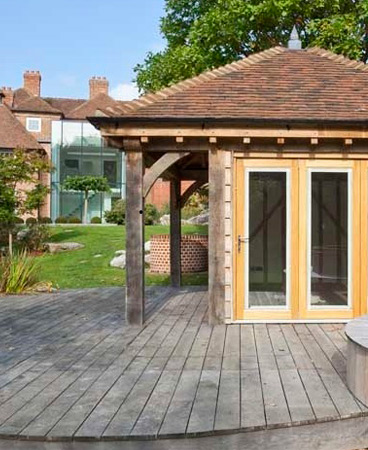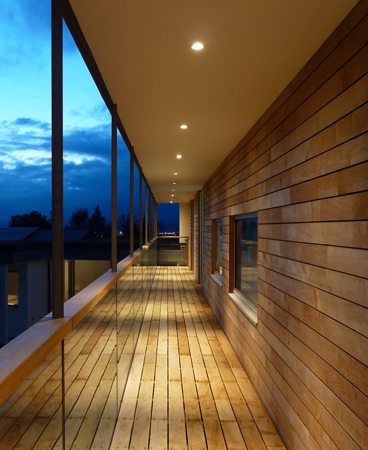Oak Decking
Oak is the Nation’s favourite wood and it is a classic choice for external hardwood decking. As well as being beautiful oak decking is hard and will last well outside.
Type
Hardwood
Profiles
VDEC 1-4
From
Britain and France

Weathered air dried oak decking 21x120mm | VDEC2

21x120mm | VDEC2 ©S2 design architects
Oak Decking Features
Oak is one of the few locally grown timbers that we use outside as well as in. The warm and tactile appearance of oak is highly attractive while the natural durability of the wood, together with its toughness, makes it ideal for upmarket decking installations.
We manufacture oak decking from English and European oak logs processed in our Wiltshire sawmills. This enables us to monitor quality and moisture levels carefully to ensure the deck boards are suitable and safe for decking installations.
Tannic Acid
Oak contains tannic acid, which corrodes ferrous metal and stains porous surfaces. It is really important that you only use stainless steel fixings. Additionally take care to keep other ferrous metal such as scaffolding away from the decking to avoid staining of the boards.
Call us to discuss your project
Specification
Oak Decking from Vastern Timber
- Dry British and European oak
- Sourced from legal and well-managed woodlands in Britain and France
- Supplied by Vastern Timber (sales@vastern.co.uk)
- Quality EN942:2007 J30
- Finished thickness of 21mm or 27mm
- Overall finished widths of 95mm / 120mm / 140mm
- Random lengths 1.5mt – 2.5mt+
- Available in various profiles
- Moisture content of 16 – 20%
- Durability EN350-2 Durable. Class 2
- Supplied uncoated. Decking oil recommended
Decking Profiles
Dimensions
| Dimensions |
|
|||||||||||||||
| Lengths |
1.5mt – 2.5mt+ |
Characteristics
Appearance
We grade the oak to be free of any major defects and problems. Oak decking boards will contain lots of small pips and a few small knots up to 30mm. Oak boards may develop small surface checks (cracks) in warm weather, but these do not affect the strength of the timber.
Weathering
Oak decking will weather to a silver-grey patina although it can respond badly to certain environments causing the wood to blacken.
Durability (EN350-2)
Durable. Class 2
Desired service life
Frequently wet 30 yrs* (This is heavily reliant on good design and installation) (Realistic service life as decking more likely to be 15 – 20yrs)
Movement class
Medium – large
Working properties
Oak is hard but it cuts well and is easy to drill.
Density
670 – 760 Kg / M3
Extractives
Oak contains tannic acid, which will corrode ferrous metals. When the two come into contact, a blue sludge is formed that will stain the oak and anything else it meets. All fixings used in conjunction with oak should be stainless steel. Tannic acid could also leave unsightly brown stains on the surface of the decking and will stain any porous materials below the decking. The reactivity of tannin makes oak cladding unsuitable for polluted areas and shaded areas
Disclaimer
While the utmost care has been taken to provide accurate information, Vastern Timber shall not be held responsible for any consequences arising from any errors or omissions on this website nor for any damages resulting from the use of the information.







